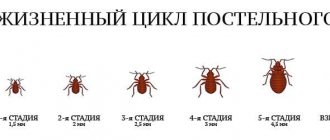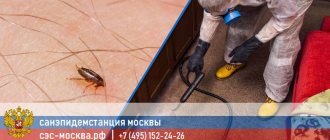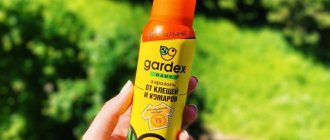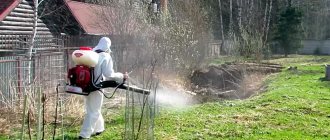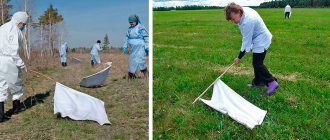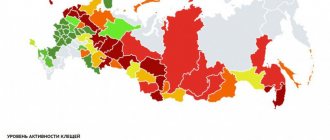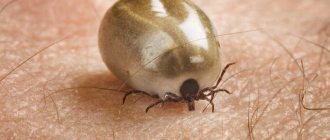Views: 5,810
There are more and more tick bites. Therefore, many owners of dachas, country houses, recreation centers, camps and other areas are wondering whether it is possible to do tick treatment on their own. Yes, you can. In this article we will look at the main points that you should pay attention to :
- What will you have to face? What pitfalls might there be along this path?
- What features do you need to know before starting acaricidal treatment?
- Is it possible to treat a summer cottage immediately against ticks and mosquitoes ?
- When should I treat the area for ticks and mosquitoes?
- When to start the first treatment ?
We will try to consider these and some other questions. We'll tell you everything you need to know about ticks and mosquitoes)
When should I start treating mosquitoes and ticks?
In spring, both ticks and mosquitoes resume their vital activity. And the degree of their activity will depend on many factors . For example, on temperature, humidity, etc. All these points must be taken into account when choosing processing time.
Effect of temperature
Ticks wake up as soon as the snow melts. They overwinter in the litter. Therefore, when positive temperatures are established, insects enter an active state. In this case, it is important how much the thermometer is above zero, as well as whether this temperature is stable or not. The best condition for tick activation is approximately 15 degrees Celsius . You can focus on this figure. If this weather lasts for several days, then it’s definitely time to start fighting bloodsuckers. This temperature is optimal for treating ticks (as it is most suitable for their life activity). As a rule, by this time the parasites have already made themselves felt.
If the spring turns out to be cold enough, this will make the ticks sluggish and passive. Another option is abnormally high spring weather - up to 30 degrees. In both cases, strong activity of blood-sucking insects may not be observed . Their development is suppressed. Therefore, processing can be postponed for a while.
However, there are exceptions. According to statistics, in some fairly cold regions, even at 5 degrees above zero, high tick activity is observed. This is explained by the fact that after hibernation the insects are very hungry and “angry” . Natural instincts give them enough aggression to overcome unfavorable environmental factors and attack their victims.
The conclusion from all of the above is the following : we must take the temperature into account. But we also do not ignore the real facts of pest attacks. If there are cases of bites, then tick treatment should be carried out without waiting for stable warm weather . However, there should no longer be snow cover. You should not poison ticks and mosquitoes when there is snow and there are puddles around. That is why most often the best time for processing is April-May .
Effect of humidity
This is an equally important indicator that is worth taking into account. For mosquitoes, wet weather is a haven . The more slush, the more they multiply. Ticks need average humidity to function actively . They depend heavily on her. If the weather is too hot and dry, the parasites will stay closer to the ground and attack less. If there are heavy rains, the insects will be washed down in drops, and they will again end up in the litter. Therefore, not too hot, not too slushy weather is optimal for them. At this time, it is best to do treatments against ticks and mosquitoes.
At the same time, humidity also affects the quality of events . Rains following insect baiting very often wash away a significant part of the insecticides from the plants. As a result, the effectiveness of tick control is greatly reduced. Therefore, weather conditions must be taken into account to achieve the best result.
Threat to people and animals
Dangerous particles are found in the saliva of ticks. Many people mistakenly believe that absolutely all pests can act harmfully. In fact, this is partly not true. Bloodsuckers attack various animals, including those infected with infectious diseases. This is how ticks become infected. Subsequently, moving to the next stage of development, the tick begins to spread harmful microorganisms to animals and humans.
So, after a bite, severe allergies develop. It manifests itself as respiratory failure, anaphylactoid reactions and rash. After a while, severe itching begins. The tick injures the skin and pathogenic microbes enter the wound, which promotes secondary infection. Some time after removing a tick is dangerous - inflammatory and purulent processes may begin to develop.
List of serious diseases for people:
- tick-borne encephalitis;
- Lyme disease;
- monocytic ehrlichiosis;
- granulocytic anaplasmosis;
- Crimean-Congo hemorrhagic fever;
- tularemia;
- relapsing tick-borne and typhus;
- great rickettsiosis;
- Q fever;
- Tsutsugamushi fever.
Ticks also pose a danger to dogs.
Common diseases in dogs:
- malaria;
- monocytic ehrlichiosis;
- babesiosis;
- Lyme disease.
How many times during the summer (season) do you need to treat ticks?
Most often, two treatments are needed per season . Provided that they were made with high quality, in compliance with technology. The first is held in April-May. The second is in the last months of summer (July-August-September). If the autumn turned out to be warm and dry, then additional procedures for the destruction of ticks will have to be done at this time of year . Here you need to judge by the epidemiological situation in the city and region and by recorded cases of pest attacks. If there are any, then acaricidal treatments must be done.
In case of heavy insect infestation, it is recommended to exterminate ticks every two months. And even more often. To find out how effectively the treatment was carried out, so-called flagging is done . What is it and how is it done, see our short video:
Flagging must be done within a few days after treatment . If, after walking one kilometer with the flag, you find at least one tick attached to it, then there is an indication for repeated destruction of the pests.
What tick repellents should I use?
As a rule, ticks are controlled using pyrethroids. The most common of them is cypermethrin. This is a synthetic drug that belongs to the group of insectoacaricides . They act not only on ticks, but also on other insects . On the one hand, this is a big plus, because... You can effectively treat your summer cottage immediately against both ticks and mosquitoes .
However, there is also a significant disadvantage. There should not be a bee apiary nearby, since bees are also susceptible to it and die along with pests . In addition, such pyrethroids have a negative effect on fish . Therefore, it is better not to use them near bodies of water.
To combat mosquito larvae living in coastal areas, there are other, safer means of disinfestation . In these cases, we advise you to contact specialists. For example, to our company. We will take into account all the nuances of the processing you need and carry it out competently.
Protection and safety measures for animals
Constant inspection of the outer coverings of pets, due to their thick fur, often does not give positive results. Therefore, a more effective way is to use special drugs.
These include:
- collar;
- spray;
- shampoo;
- drops on the withers.
They are used to eradicate ectoparasites. The drops are applied once, as they retain their properties for several months. Owners of animals living in Russia must purchase only domestically produced anti-parasite products.
Eg:
- anti-parasitic collars from Toro;
- drops on the withers and sprays from the leading Russian manufacturer Apicenna.
The collar and shampoo provide little protective effect, so they are used as an auxiliary measure.
What to consider when carrying out treatment against ticks and mosquitoes with your own hands?
It is advisable to mow the grass before the event. The procedure for exterminating pests is carried out by spraying . A solution of insecticides is pre-prepared (see the instructions for the selected product for the dosage and ratio with water).
For spraying it is better to use professional equipment. It is adapted for uniform distribution of the smallest drops of substance ( in the form of cold fog ) over the vegetation cover. This is difficult to achieve with a regular garden sprayer. In addition, special equipment makes it possible to treat large areas of territory against ticks in a short time . A household sprayer usually only works to a limited extent.
What else do you need to know?
We are supplementing our article with a series of short answers to the most frequently asked questions . We have encountered them many times in our work. They concern both those who decided to carry out tick treatment themselves and those who used the services of exterminators.
Here are some of them:
#1. When can a child be allowed to walk on the grass after being treated for ticks?
When treating with pyrethroids, you need to wait 2-3 hours after the procedure so that the drug has time to dry. After this you can go for a walk. But it is necessary to monitor small children so that they do not put blades of grass, berries, or flowers into their mouths. Although pyrethroids are relatively non-toxic, they are still chemicals. And its entry into the body is undesirable. Especially the bodies of children.
#2. Does mite treatment affect crop yield?
The vegetation itself does not accumulate acaricidal agents . And they do not in any way affect the development of plants and their maturation . But if the destruction of pests took place in the immediate vicinity of gardens and vegetable gardens, then anti-mite preparations can settle on the surface of growing crops. In this case, eating something “from the garden” is not worth it.
However, harvesting can and should be done. pre-rinse all vegetables, fruits and berries . After this they can be eaten.
#3. How long after tick treatment can I pick berries and mushrooms?
You can collect it in a few hours. However, it is important:
– don’t eat berries on the go;
– wear special clothing that prevents the drug from getting from the plants onto the body;
– wash your hands thoroughly after collecting the gifts of nature;
– Wash all collected mushrooms and berries before eating or cooking;
– wash clothes after the hike.
If these conditions are met, there will be no negative health consequences.
#4. Does treating an area for ticks and mosquitoes harm pollinating insects?
If the baiting was carried out with drugs from the group of insectoacaricides (i.e., agents that affect not only ticks, but also other insects), then yes, such treatment can really harm bees and other pollinators . Therefore, in the immediate vicinity of an apiary, it is necessary to combat parasites with specific acaricides . These are drugs that specifically act on ticks . They have minimal effect on other insects.
#5. Is it possible to treat the area against ticks and mosquitoes in the rain?
No, this is highly not recommended . In fact, the effectiveness of such processing approaches zero. It's better to wait for dry weather. And it is advisable to choose the time so that after disinsection there will be at least three days without rain . Follow the weather forecast!
#6. Does it matter the time of day at which ticks and mosquitoes are exterminated?
We recommend carrying out treatments in the morning . The main thing is that the dew has already evaporated and it is dry and warm.
What else to read about ticks:
– Tick-borne diseases No. 3
– Borreliosis – disease No. 2 caused by a tick bite
– Do I need to be vaccinated against ticks?
– Tick-borne encephalitis is the No. 1 disease caused by a tick bite
– How do ixodid ticks attack?
– Features of ixodid ticks: what do you need to know?
How can you tell if there are ticks on your property?
Before starting the treatment process, you must check the area for ticks. This needs to be done twice - before and after processing. The first time to detect ticks, the second, on the contrary, to make sure that they are absent. The simplest and most effective way is to use a white “flag”.
However, before entering the area, it is necessary to protect the body from possible bites. There are a number of measures that can protect you from negative impacts:
- vaccination course against tick-borne encephalitis;
- treating clothing with an aerosol or anti-tick spray (applying it to the body does not make sense, since the substances are interrupted by sweat);
- hermetically seal all exposed parts of the body;
- gather your hair into a bun and tuck your pants into your shoes;
- choose a light color of clothing so as not to miss a tick when inspecting it.
The white “flag” is made from white fleecy fabric using waffle or flannel fabric, which must be treated with human or animal sweat to attract ticks. The design of the “flag” itself is similar and reminiscent of a real flag and is made as follows: fabric is tied to the end and middle of a long stick so that the design looks like a flag.
The verification process involves passing the area several times and applying a “flag” so that it confidently touches the plant surface. You need to walk slowly, avoiding twisting. Every 50 steps it is necessary to check the “flag” for the presence of ticks or plant debris. At the end of the diagnosis, the approximate number of ticks in the entire area of the site will become clear. To avoid getting bitten by a tick, it is important to carefully inspect your clothing before removing it.



